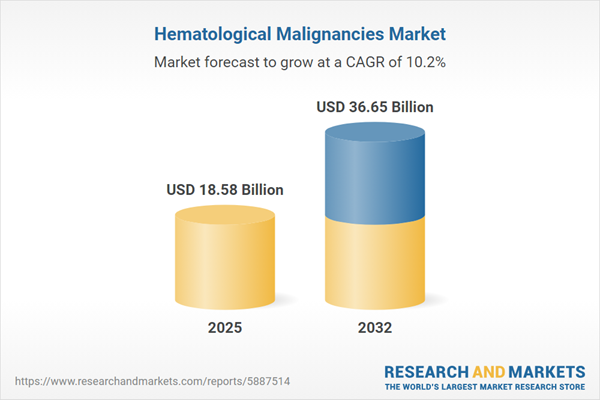Speak directly to the analyst to clarify any post sales queries you may have.
The hematological malignancies market is evolving rapidly, driven by advancements in diagnostics, innovative therapies, and digital health integration. Senior decision-makers face increased pressure to respond to shifting care models and regulatory changes while maintaining growth and operational efficiency.
Market Snapshot: Hematological Malignancies Market
In 2024, the hematological malignancies market was valued at USD 16.84 billion, with projections showing expansion to USD 18.58 billion in 2025. The sector is forecast to grow at a CAGR of 10.20%, reaching USD 36.65 billion by 2032. Momentum in molecular diagnostics is improving precision in disease identification and treatment selection, resulting in greater clinical efficiency. Updated care standards and new therapeutic modalities are shaping clinical decision-making, while digital health platforms are streamlining patient management. Shifts in reimbursement policies and regulatory environments prompt organizations to reassess their investment priorities and operational frameworks to adapt to future demands.
Scope & Segmentation of the Hematological Malignancies Market
This executive overview delivers a detailed analysis across the hematological malignancies value chain, empowering leadership with vital segmentation for optimal strategic resource allocation and effective risk management.
- Disease Types: Analysis covers acute and chronic leukemias, Hodgkin and non-Hodgkin lymphoma, multiple myeloma, myelodysplastic syndromes, and myeloproliferative neoplasms. Segmentation includes both broad-spectrum and rare subtypes to aid targeted forecasting and product strategy development.
- Treatment Types: Covers chemotherapy, CAR-T cell therapy, checkpoint inhibitors, stem cell transplantation, and targeted therapies. These insights support executives evaluating clinical adoption rates and monitoring shifts in therapeutic protocols.
- Therapy Classes: Details cellular therapies, immunomodulatory agents, monoclonal antibodies, and small molecule inhibitors. Mapping technological uptake guides investment decisions and reveals emerging innovation patterns.
- Line of Therapy: Evaluates utilization in first-line and subsequent therapies. Examining treatment sequencing helps define resistance management strategies and clarifies patient care trajectories.
- End Users: Profiles ambulatory centers, hospitals, specialty clinics, and research institutions to compare differences in healthcare delivery and technology adoption among provider types.
- Distribution Channels: Investigates direct procurement, hospital inventory flows, online platforms, and retail pharmacies. Understanding these channels informs supply chain optimization and market access planning.
- Patient Age Groups: Segmentation includes adult, pediatric, and geriatric patient groups, highlighting unique therapeutic requirements and supporting efficient planning for resource deployment and care delivery.
- Regions: Strategic analysis addresses the Americas, Europe, Middle East & Africa, and Asia-Pacific. The section considers regulatory diversity, infrastructure maturity, and the variability of access to advanced therapies within each region.
- Key Companies: The report benchmarks leading industry participants such as Bristol-Myers Squibb Company, Johnson & Johnson, AbbVie Inc., F. Hoffmann-La Roche AG, Novartis AG, Gilead Sciences, Inc., Pfizer Inc., Amgen Inc., Sanofi S.A., and Takeda Pharmaceutical Company Limited, enabling informed competitive and partnership assessment.
Key Takeaways for Senior Decision-Makers
- Immunotherapy advancements and digital health solutions are transforming patient stratification and advancing personalized treatment approaches for complex blood cancers.
- AI and machine learning are driving new efficiencies in diagnostics, supporting data-driven decisions throughout the drug development lifecycle.
- Partnerships between established pharmaceutical firms and emerging biotech companies foster innovation, accelerate clinical protocol evolution, and increase worldwide therapy access.
- Expanding deployment of gene and cell therapies highlights the need for resilient supply chain solutions and thorough compliance with evolving standards.
- Regional differences in payer models and health systems necessitate focused market entry strategies and tailored partnership models for successful global positioning.
Tariff Impact: US Import Tariffs in 2025
The introduction of US import tariffs on pharmaceuticals and laboratory equipment in 2025 creates additional cost pressures and operational challenges throughout the hematological malignancies market supply chain. Key stakeholders are reviewing supplier relationships and implementing robust risk management protocols. Smaller biotech firms may experience greater regulatory and logistical hurdles, potentially impacting development timelines and therapy availability.
Methodology & Data Sources
Findings in this report are based on comprehensive interviews with oncology and regulatory experts, combined with a thorough review of peer-reviewed literature. A multi-source triangulation approach ensures accuracy and provides actionable segment-level insights for senior leaders planning market strategy.
Why This Report Matters
- Supports executive teams in forecasting shifts related to therapies, regulations, and digital health technology across the hematological malignancies market.
- Delivers grounded intelligence for organizations to quickly respond to evolving market conditions and manage associated operational risks effectively.
- Strengthens comparative analysis and risk mitigation when assessing product positioning and potential strategic partnerships.
Conclusion
Dynamic progress in diagnostics, therapies, and care delivery is redefining the hematological malignancies industry landscape. Agile strategy and ongoing operational diligence remain critical for long-term success for sector leaders.
Additional Product Information:
- Purchase of this report includes 1 year online access with quarterly updates.
- This report can be updated on request. Please contact our Customer Experience team using the Ask a Question widget on our website.
Table of Contents
3. Executive Summary
4. Market Overview
7. Cumulative Impact of Artificial Intelligence 2025
Companies Mentioned
The companies profiled in this Hematological Malignancies market report include:- Bristol-Myers Squibb Company
- Johnson & Johnson
- AbbVie Inc.
- F. Hoffmann-La Roche AG
- Novartis AG
- Gilead Sciences, Inc.
- Pfizer Inc.
- Amgen Inc.
- Sanofi S.A.
- Takeda Pharmaceutical Company Limited
Table Information
| Report Attribute | Details |
|---|---|
| No. of Pages | 185 |
| Published | November 2025 |
| Forecast Period | 2025 - 2032 |
| Estimated Market Value ( USD | $ 18.58 Billion |
| Forecasted Market Value ( USD | $ 36.65 Billion |
| Compound Annual Growth Rate | 10.2% |
| Regions Covered | Global |
| No. of Companies Mentioned | 11 |









